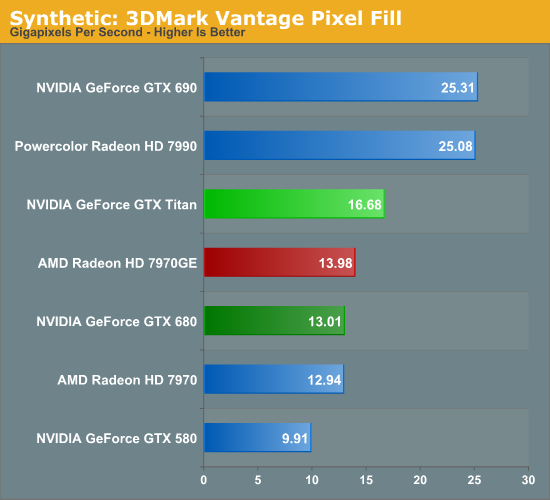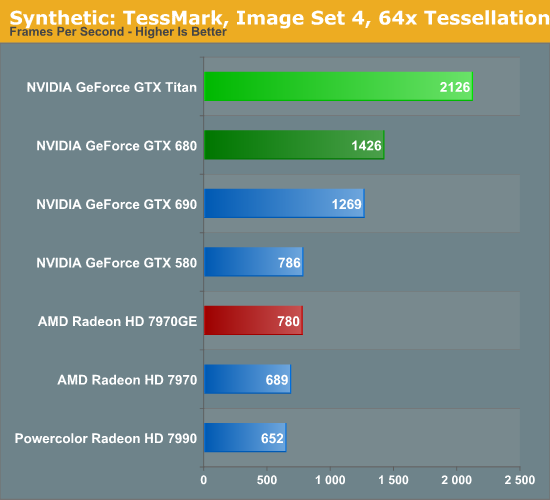NVIDIA’s GeForce GTX Titan Review, Part 2: Titan's Performance Unveiled
by Ryan Smith & Rahul Garg on February 21, 2013 9:00 AM ESTSynthetics
As always we’ll also take a quick look at synthetic performance to get a better look at Titan’s underpinnings. These tests are mostly for comparing cards from within a manufacturer, as opposed to directly comparing AMD and NVIDIA cards. We’ll start with 3DMark Vantage’s Pixel Fill test.

Pixel fill is a mix of a ROP test and a test to see if you have enough bandwidth to feed those ROPs. At the same time the smallest increase in theoretical performance for Titan over GTX 680 was in ROP performance, where a 50% increase in ROPs was met with a minor clockspeed reduction for a final increase in ROP performance of 25%.
The end result is that with gains of 28%, Titan’s lead over GTX 680 is just a hair more than its increase in theoretical ROP performance. Consequently at first glance it looks like Titan has enough memory and cache bandwidth to feed its 48 ROPs, which given where we’re at today with GDDR5 is good news as GDDR5 has very nearly run out of room.
Moving on, we have our 3DMark Vantage texture fillrate test, which does for texels and texture mapping units what the previous test does for ROPs.

Oddly enough, despite the fact that Titan’s texture performance improvements over GTX 680 were only on the range of 46%, here Titan is measured as having 62% more texturing performance. This may be how Titan is interplaying with its improved bandwidth, or it may be a case where some of the ancillary changes NVIDIA made to the texture paths for compute are somehow also beneficial to proper texturing performance.
Finally we’ll take a quick look at tessellation performance with TessMark.

Unsurprisingly, Titan is well ahead of anything else NVIDIA produces. At 49% faster it’s just a bit over the 46% theoretical performance improvement we would expect from the increased number of Polymorph Engines the extra 6 SMXes bring. Interestingly, as fast as GTX 580’s tessellation performance was, these results would indicate that Titan offers more than a generational jump in tessellation performance, nearly tripling GTX 580’s tessellation performance. Though at this time it’s not at all clear just what such tessellation performance is good for, as we seem to be reaching increasingly ridiculous levels.










337 Comments
View All Comments
piiman - Saturday, February 23, 2013 - link
Yes a $1000.00 GPU is a luxury. Don't want luxury use the on board GPU and have a blast! :-)CeriseCogburn - Sunday, February 24, 2013 - link
ANY GPU over about $100 to $150 bucks is a LUXURY PRODUCT.Of course we can get you a brand spankin new gpu for $20 after rebate DX11 capable with a gig of ram, GTX 600 series, ready to rock out, even fit in your HTPC.
So stop playing so stupid and so ridiculous. Why is stupidity so cool and so popular with you puke brains ?
A hundred bucks can get one a very reasonable GPU that will play everything now available with a quite tolerable eye candy pain level, so the point is dummy, THERE ARE THOUSANDS OF NON LUXURY GPU's, JUST LIKE THERE ARE ALWAYS A FEW DOZEN LUXURY GPU's.
So your faux aghast smarmy idiot comment about I thought GPU's were commodities fits right in with the retard liar shortbus so stuffed to the brim with the clowns we have here.
You're welcome, I'm certain that helped.
Ankarah - Thursday, February 21, 2013 - link
Could then you care to explain why any of those ultra enthusiasts would choose this card over the 690GTX, which seems to be faster overall?And let's leave the power consumption between the two out of this discussion - if you can drop a grand on your graphics card for your PC, then you can afford a big power supply too.
sherlockwing - Thursday, February 21, 2013 - link
You haven't seen the SLI benches yet.This card in SLI will perform better than GTX 690 in SLI due to bad scaling for Quad SLI.
sherlockwing - Thursday, February 21, 2013 - link
Correction: It will be better than GTX 690 SLI if you overclock the Titan to 1Ghz, 690 don't really have that much OC headroom.CeriseCogburn - Saturday, February 23, 2013 - link
did you say overclock ?" In our testing, NVIDIA’s GK110 core had no issue hitting a Boost Clock of 1162MHz but hit right into the Power Limit, despite it being set at 106%. Memory was also ready to overclock and hit a speed of 6676MHz. As you can see in the quick benchmarks below, this led to a performance increase of about 15%. "
So, that's the 27mhz MAX the review here claims...LOL
Yep, a 15% performance increase, or a lousy 27mhz, you decide.... amd fanboy fruiter, or real world overclocker...
http://www.hardwarecanucks.com/forum/hardware-canu...
Alucard291 - Thursday, February 21, 2013 - link
Well as Ryan said in the article its "removed from the price curve" which in human language means: Its priced badly and is hoping to gain sales from publicity as opposed to quality.Oxford Guy - Thursday, February 21, 2013 - link
Hence the "luxury product" meme.trajan2448 - Thursday, February 21, 2013 - link
Learn about latencies and micro stuttering, driver issues, heat and noise. Almost 50% better in frame latencies than 7970. Crossfire,don't make me laugh. here's an analysis.http://www.pcper.com/reviews/G...
CeriseCogburn - Thursday, February 21, 2013 - link
correcting that link for you again, that shows the PATHETIC amd crap videocard loser for what it ishttp://www.pcper.com/reviews/Graphics-Cards/NVIDIA...